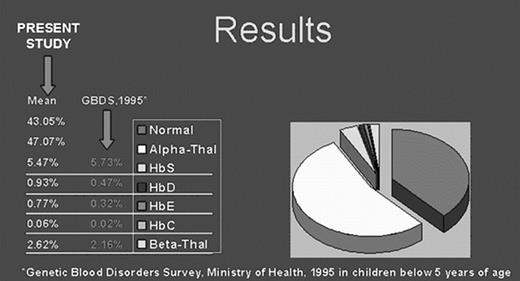Abstract
Objective: The aim of the study was to establish neonatal cord blood screening in the Sultanate of Oman, in an effort to determine the prevalence of haemoglobinopathies by a cost-effective method.
Background: Oman is a country with a two million population comprising of a wide range of ethnic groups, high rates of consanguinity and increased incidences of inter-cousin marriages all leading to an increased prevalence of haemoglobinopathies. High performance liquid chromatography [HPLC] is a powerful tool to screen newborns for haemoglobinopathies. Neonatal screening includes cord blood samples collection, screening and follow up of all newborns with abnormal results.
Methods: A total of 7837 consecutive cord blood samples were screened for the presence of possible haemoglobinopathies by HPLC using Biorad Variant II program between April 2005 & March 2007. Complete blood counts [CBC] were also obtained on Cell Dyn 4000 automated blood cell counter. All samples were then processed to isolate and store mononuclear leukocytes for subsequent molecular diagnostics.
Results: The findings indicated a 47.07% incidence of α-thalassaemia, based on low mean cell volume [MCV] & mean cell haemoglobin [MCH] on the CBC and significant amounts of Hb Barts on HPLC. Furthermore, the overall incidence of other haemoglobinopathies was 9.87%, with 5.47% incidence of sickle haemoglobin. On HPLC, D-window, E-window and C-window were present in 0.93%, 0.77% and 0.06% of the samples respectively.
Since HPLC cannot diagnose beta thalassemia major at birth, in samples with HbA below 10%, the beta globin gene was directly sequenced including the promoter, all exons and introns in these samples. Amongst 206(2.62%) samples sequenced, beta thalassaemia trait was confirmed in 201 cases and 5 cases were homozygous for beta thalassaemia. Additionally, direct sequencing of all abnormal samples with HbS,[n=429] HbD,[n=73], HbE[n=42] and HbC[n=5] was also performed on ABI 3100 Genetic Analyzer to assign the genotype status to these subjects and to validate the HPLC results. Amongst the 429 samples with HbS sequenced, 24 samples were homozygous (0.3%) and were referred for comprehensive clinical care programme.
Conclusions: The significantly high incidence of haemoglobinopathies in newborns in the Sultanate of Oman emphasizes the value of neonatal cord blood screening to be implemented as the first step in the national strategy towards total management of haemoglobinopathies including early diagnosis, comprehensive clinical care and counseling of the affected families. The results of this large study indicate that using HPLC [<2 USD/sample] and prescreening of parents to select only abnormal samples for neonatal cord blood screening [<10% samples] can be recommended as a highly cost-effective method targeted to screen only the abnormal samples.
Author notes
Disclosure:Research Funding: The study was funded by HIS Majesty’s Research Grant SR/MED/HAEM/05/01.


